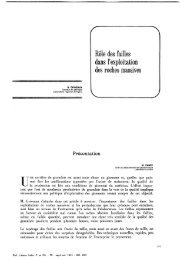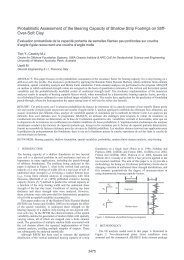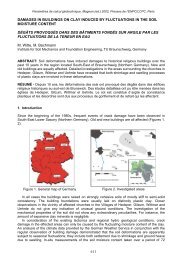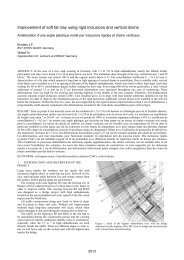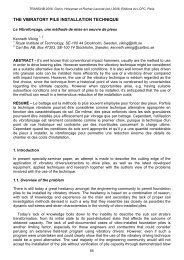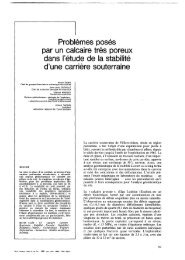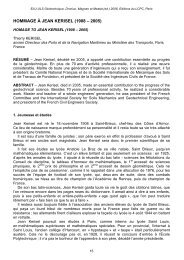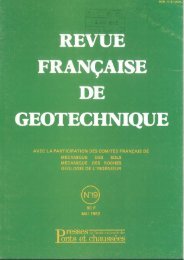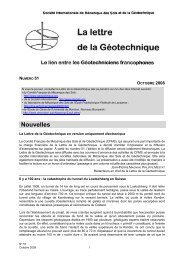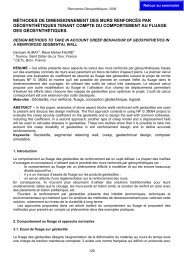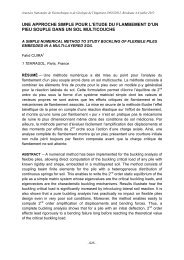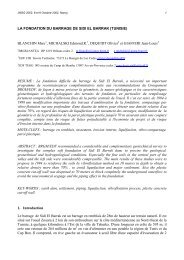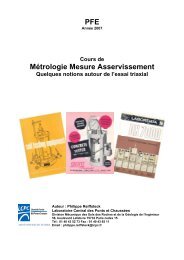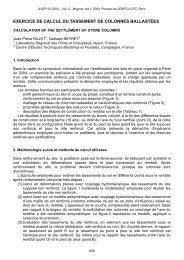Stabilité des talus : 2. Déblais et remblais
Stabilité des talus : 2. Déblais et remblais
Stabilité des talus : 2. Déblais et remblais
Create successful ePaper yourself
Turn your PDF publications into a flip-book with our unique Google optimized e-Paper software.
From this angle, the principal elements gathered as a result of the study of the influence of the param<strong>et</strong>ers<br />
of tests on the measurement of shear strength of stiff clay are presented. It is noted that when<br />
the dimensions and orientation of the samples and the rate of testing are varied, the shear strength<br />
measured varies substantially in the case of the four French soils tested :<br />
— Flanders clay (Ypresian)<br />
— Provins clay (Sparnacian)<br />
— Dozule clay (Callovo-Oxfordian)<br />
— Sannoisien green clay (Oligocene)<br />
An attempt was made to relate these results to the mineralogical texture of the soils tested, and for<br />
this purpose recourse was had to the classification of different textures of argillaceous and marly rocks<br />
developed by the LCPC and elaborated upon in this report.<br />
To complement this data, three interesting cases of cuttings are presented, two of them very thoroughly<br />
instrumented. At the Northern entrance to Lyon, on Autoroute A6, the Tronchon cutting (12 m<strong>et</strong>res<br />
deep), excavated in fairly stiff gravelly clay, gave rise to a tricky hydraulic problem which was treated<br />
with an electric analog model adjusted to in situ measurements. Furthermore, the size of the coarse<br />
elements present in the soil necessitated the use of a giant triaxial test apparatus (diam<strong>et</strong>er 30 cm for<br />
the samples) for the measurement of the mechanical param<strong>et</strong>ers; this gave satisfactory results.<br />
The Bosse-Galan experimental cutting was excavated in normally consolidated soft clay. An attempt<br />
was made to d<strong>et</strong>ermine the conditions of stability of this cutting in the short term to a height of 5 m<strong>et</strong>res,<br />
and the long term evolution of the hydraulic conditions. Calculations of stability under total stresses<br />
were invalidated by experience (failure occured at a depth less than the predicted critical depth).<br />
Calculations under effective stresses based on measured pore pressures were fairly accurate. The deformations<br />
observed in the short term were not those of a soil evolving at constant volume; this may be<br />
attributed either to non-saturation of the original material or to a more rapid long term passage than<br />
was predicted.<br />
Two slips of different kinds occured at Rognac on Autoroute A7 North of Marseille. One of them<br />
occured while work was in progress in a 25-m<strong>et</strong>re cutting excavated in an alternation of sandstone and<br />
marl whose hydraulic conditions had been underestimated at the stage of preliminary investigation.<br />
The slip was remedied by reducing the angle of slope initially planned and by adding large drainage<br />
spurs. The second slip was the reactivation of a former slip in a zone analogous to the preceding one<br />
but in which the alignment caused little change in the natural geom<strong>et</strong>ry. It was treated by adding a<br />
drainage curtain to the slope and placing an abutment at the foot of the slope.<br />
PART 2<br />
EMBANKMENTS ON SOFT SOILS<br />
The general report first briefly s<strong>et</strong>s forth the conventional m<strong>et</strong>hods of studying stability. There follows<br />
an examination of the real behaviour of embankments which have suffered disturbances, commencing<br />
with a reference to structures observed by the Laboratoires <strong>des</strong> Ponts <strong>et</strong> Chaussées. Relating these<br />
examples to those contained in the international literature on the subject, disparities b<strong>et</strong>ween predicted<br />
behaviour and real behaviour are revealed. The causes of these disparities are the subject of a d<strong>et</strong>ailed<br />
analysis in which an examination is made of factors such as the shape of the failure curve, allowance for<br />
strength in the embankment, and the effect of weather and anisotropy on the undrained cohesion C u<br />
of the foundation soil. Also examined are the results of the calculation of effective stresses; and calculations<br />
of movements are also presented.<br />
The two following articles deal with the measurement of the param<strong>et</strong>ers of resistance of the foundation<br />
soil. First comes a <strong>des</strong>cription of a vane test apparatus with coaxial bla<strong>des</strong>, making it possible to measure<br />
separately shear strengt in the horizontal and vertical planes. An account is then given of a seris of<br />
laboratory tests making it possible to d<strong>et</strong>ermine the law of behaviour (CAU tests) allowing for the<br />
initial state of the soil (K 0 state), rate of shearing, and anisotropy.<br />
The final two articles <strong>des</strong>cribe two observed failures of embankments on soft soils. The first, induced<br />
experimentally near Lorient, was the subject of numerous measurements which are briefly reported,<br />
with emphasis on the analysis of pore pressures, the calculation of effective stresses, and the interpr<strong>et</strong>ation<br />
of displacements by elastic analysis. The second failure was observed during the construction<br />
of a trial embankment, and is an example of an unexpected failure; the calculated coefficient of saf<strong>et</strong>y<br />
does not make it possible to foresee such disorders.<br />
PART 3<br />
REMEDIAL MEASURES<br />
Two important points concerning the strengthening of embankments are dealt with :<br />
— The strengthening of overall stability by means of drainage systems : drainage trenches, drainage<br />
spurs, subhorizontal drains and shafts. The principles of these systems are explained, and diagrammatic<br />
cross-sections are given, specifying the respective proportions and the way they are built. Examples<br />
of applications of the various systems are given.<br />
— Reinforcement in respect of surface erosion, which can be a serious problem, especially in regions<br />
subject to rainstorms, as in the South of France. On the basis of studies and observations made in<br />
Alsace and Provence, d<strong>et</strong>ails are given of the different m<strong>et</strong>hods of stabilization which can be employed,<br />
in the light of weather conditions, pedological conditions, and the geom<strong>et</strong>ry of the slopes concerned :<br />
topsoil treatment, the use of sprayed chemicals, and stabilizing layers of various materials applied<br />
mechanically.



